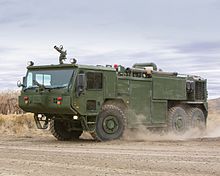
The Heavy Expanded Mobility Tactical Truck (HEMTT) is an eight-wheel drive, diesel-powered, 10-short-ton (9,100 kg) tactical truck. The M977 HEMTT first entered service in 1982 with the United States Army as a replacement for the M520 Goer, and since that date has remained in production for the U.S. Army and other nations. By Q2 2021, around 35,800 HEMTTs in various configurations had been produced by Oshkosh Defense through new-build contracts and around 14,000 of these had been re-manufactured. Current variants have the A4 suffix.

A fire engine is a road vehicle that functions as a firefighting apparatus. The primary purposes of a fire engine include transporting firefighters and water to an incident as well as carrying equipment for firefighting operations. Some fire engines have specialized functions, such as wildfire suppression and aircraft rescue and firefighting, and may also carry equipment for technical rescue.

The Expeditionary Fighting Vehicle (EFV) was an amphibious assault vehicle developed by General Dynamics during the 1990s and 2000s for use by the U.S. Marine Corps. It would have been launched at sea, from an amphibious assault ship beyond the horizon, able to transport a full Marine rifle squad to shore. It would maneuver cross country with an agility and mobility equal to or greater than the M1 Abrams.

The Assault Amphibious Vehicle (AAV)—official designation AAVP-7A1 —is a fully tracked amphibious landing vehicle manufactured by U.S. Combat Systems.

Oshkosh Corporation, formerly Oshkosh Truck, is an American industrial company that designs and builds specialty trucks, military vehicles, truck bodies, airport fire apparatus, and access equipment. The corporation also owns Pierce Manufacturing, a fire apparatus manufacturer in Appleton, Wisconsin, and JLG Industries, a leading manufacturer of lift equipment, including aerial lifts, boom lifts, scissor lifts, telehandlers and low-level access lifts. Based in Oshkosh, Wisconsin, the company employs approximately 16,000 people around the world. It is organized in four primary business groups: access equipment, defense, fire and emergency, and commercial.

The Medium Tactical Vehicle Replacement (MTVR) is a series of vehicles, based on a common chassis that vary by payload and mission requirements. The MTVR is a purpose-designed military vehicle, although a small number of vehicles have been sold commercially for specialized operations such as wildfire fighting.
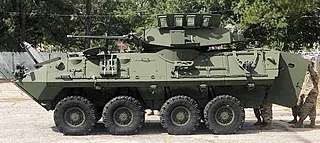
The LAV-25 is an eight-wheeled amphibious armored reconnaissance vehicle built by General Dynamics Land Systems and used by the United States Marine Corps and the United States Army.

Aircraft rescue and firefighting (ARFF) is a type of firefighting that involves the emergency response, mitigation, evacuation, and rescue of passengers and crew of aircraft involved in aviation accidents and incidents.

The Family of Medium Tactical Vehicles (FMTV) is a series of vehicles, based on a common chassis, that vary by payload and mission requirements. The FMTV is derived from the Austrian Steyr 12M18 truck, but substantially modified to meet U.S. Army requirements, these including a minimum 50 percent U.S. content.

The Port Authority of New York and New Jersey Police Department, or Port Authority Police Department (PAPD), is a law enforcement agency in New York and New Jersey, the duties of which are to protect and to enforce state and city laws at all the facilities, owned or operated by the Port Authority of New York and New Jersey (PANYNJ), the bi-state agency running airports, seaports, and many bridges and tunnels within the Port of New York and New Jersey. Additionally, the PAPD is responsible for other PANYNJ properties including three bus terminals, the World Trade Center in Lower Manhattan, and the PATH train system. The PAPD is the largest transit-related police force in the United States.

The Logistics Vehicle System (LVS), nicknamed by U.S. Marines as "Dragon Wagon", is a modular assortment of eight-wheel drive all-terrain vehicle unit combinations used by the United States Marine Corps.
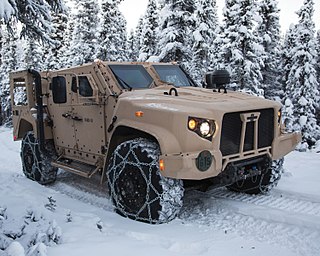
The Joint Light Tactical Vehicle (JLTV) is a United States military and United States Special Operations Command program to part-replace the Humvee with a family of more survivable vehicles with greater payload. Early studies for the JLTV program were approved in 2006. The JLTV program incorporates lessons learned from the earlier Future Tactical Truck Systems program and other associated efforts.

The M1120 HEMTT LHS is a M977 Heavy Expanded Mobility Tactical Truck with a load handling system in place of a flat bed/cargo body. The HEMTT is an eight-wheel drive, diesel-powered, tactical truck used by the US military and others. The HEMTT is manufactured by Oshkosh Defense and entered Army service in 1982, with the M1120 variant first produced in 1999.

The Oshkosh M-ATV is a Mine Resistant Ambush Protected (MRAP) vehicle developed by the Oshkosh Corporation for the MRAP All Terrain Vehicle (M-ATV) program. Intended to replace M1114 HMMWVs (Humvee), it is designed to provide the same levels of protection as the larger and heavier previous MRAPs, but with improved mobility.

The AN/TPS-80 Ground/Air Task Oriented Radar (G/ATOR) is the United States Marine Corps next generation Air Surveillance/Air Defense and Air Traffic Control (ATC) Radar. The mobile active electronically scanned array radar system is currently being developed by Northrop Grumman and was expected to reach initial operating capability in August 2016.

The Oshkosh L-ATV is a light utility/combat multi-role vehicle that won the US military's Army-led Joint Light Tactical Vehicle (JLTV) program. In the very early stages of the program it was suggested that JLTV would replace the AM General High Mobility Multi-purpose Wheeled Vehicle (HMMWV) on a one-for-one basis. It is now suggested that the JLTV will part-replace the HMMWV, not replacing it on a like-for-like basis.
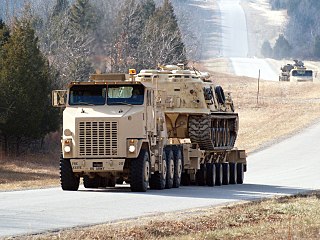
The Oshkosh M1070 is a U.S. Army tank transporter tractor unit. In current service in A0, A1, and M1300 configurations, the M1070 is coupled to a DRS Technologies M1000 semi-trailer. The primary purpose of this combination for the U.S. Army is the transport of the M1 Abrams tank. The M1300, covered in a separate sub-section, is a U.S. Army Europe-specific derivative designed to be road legal within Europe and operates with a different trailer.

The Logistic Vehicle System Replacement (LVSR) is a family of heavy-duty military logistics vehicles of the United States Marine Corps (USMC) based on a common 5-axle ten-wheel drive (10x10) chassis. The vehicles vary in individual configuration by mission requirements, with three variants in service: a cargo, a wrecker and a tractor truck. The LVSR was designed and is manufactured by Oshkosh Defense.
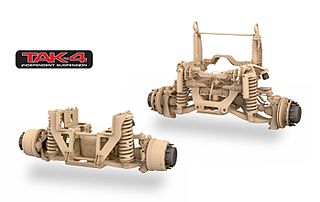
TAK-4 independent suspension system is a family of independent suspension systems designed and manufactured by Oshkosh Corporation for use on military, severe-duty and emergency vehicles. The system was developed from the mid-1990s.


